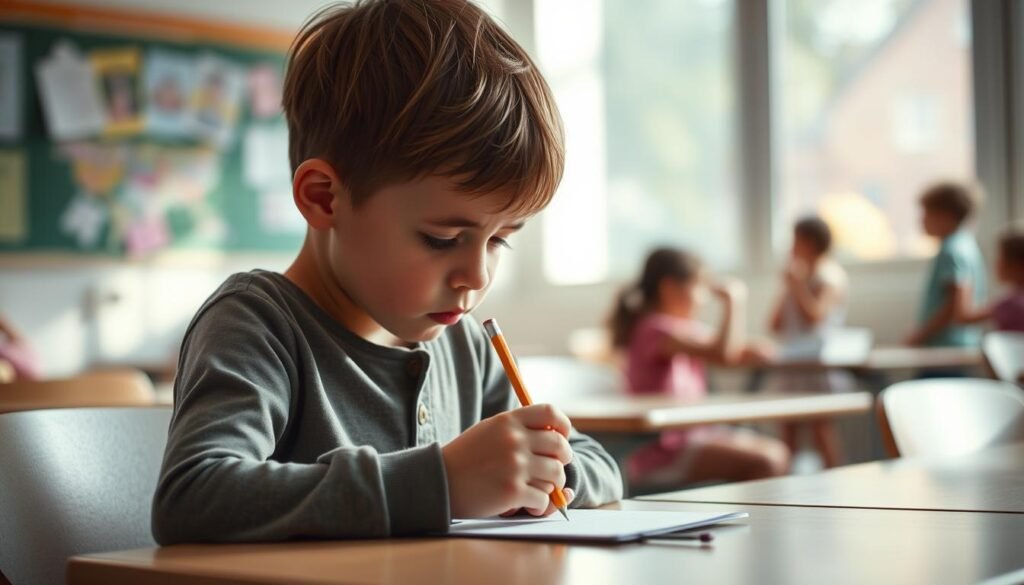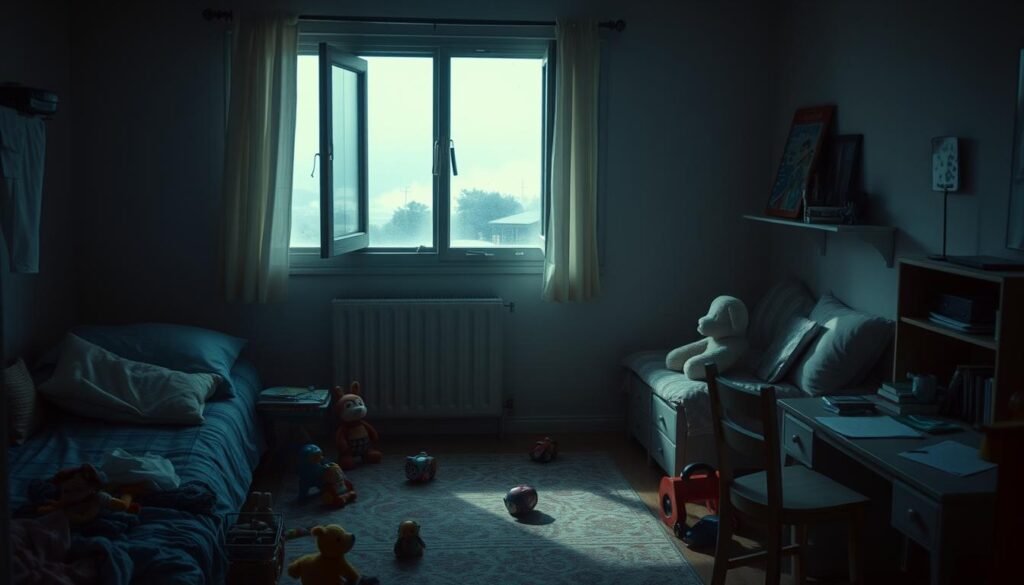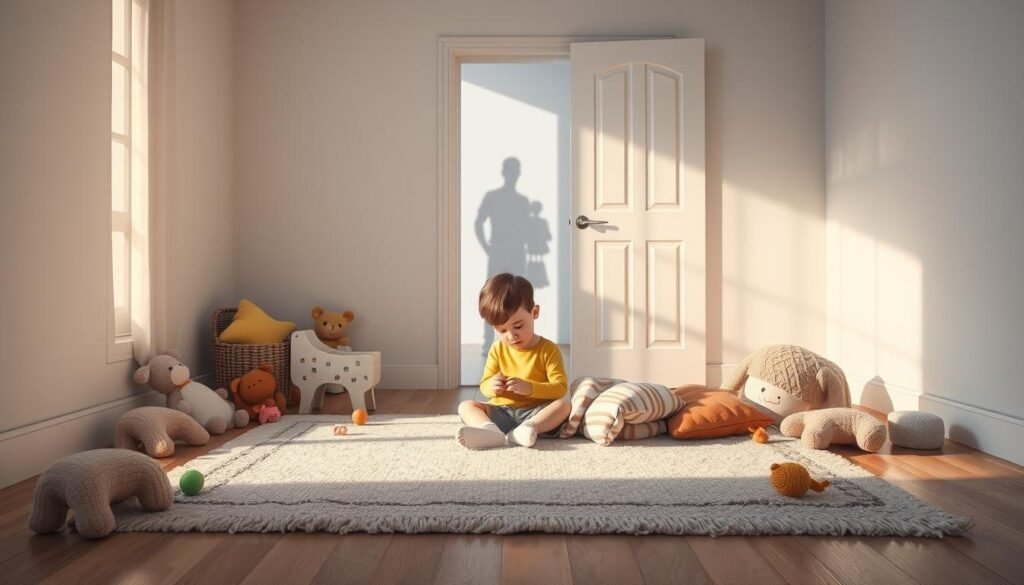Did you know that about 9% of kids from 3 to 17 years old are found to have an anxiety disorder? The Centers for Disease Control and Prevention (CDC) shared this fact. This shows how important it is to spot signs of anxiety in 8-year-olds early. Anxiety is more than just a phase for many children; it can greatly affect their daily life. Parents need to know the signs of anxiety in children to help them.
Often, anxiety shows up during big life changes, like starting at a new school or moving homes. This makes it even more crucial to understand anxiety in children. By knowing these signs, parents and caregivers can support their children through their feelings. This support helps create a caring environment for the kids.
Key Takeaways
- Approximately 9% of children aged 3 to 17 experience anxiety disorders.
- Common symptoms can include moodiness, sleep problems, and school refusal.
- Signs may become evident around transitions like starting school.
- Anxiety affects both boys and girls, though it’s more prevalent in girls.
- Early detection of anxiety symptoms can lead to timely and effective treatment.
- Consulting a pediatrician is essential if a child demonstrates unusual behaviors.
- Understanding symptoms can aid in building a supportive environment.
Understanding Anxiety Disorders in Childhood
Learning about anxiety disorders in kids shows important insights. About 1 in 8 children in the United States struggle with them. These issues affect kids’ lives at home, school, and with friends between 6 to 10 years old. Knowing the difference between normal fear and ongoing anxiety is key. Signs of anxiety in kids ages 6-10 include too much worry, being unable to relax, and getting upset easily.
The average age when anxiety disorders start is about six. This shows why it’s so important to identify and treat it early. For example, around 4% of kids 7 to 11 years old face separation anxiety. They are extremely scared of being apart from those they care about. Without help, these fears can lead to bigger emotional issues later.
If childhood anxiety is not treated, it can lead to depression and other mental health problems. Studies have found that around 32% of kids with anxiety don’t get the help they need. But there’s good news. Treatments like cognitive behavioral therapy (CBT) work well in 60-80% of the cases. This highlights how vital proper help is for kids dealing with anxiety.
Knowing about these disorders helps parents and caregivers spot the signs early. It’s crucial for families to understand what these kids face. This support helps them grow up strong and able to deal with challenges in their early years.
Common 8 Year-Old Anxiety Symptoms
Recognizing the symptoms of anxiety in 8 year-olds can be vital for parents. Symptoms show up in different ways, affecting kids physically, emotionally, and behaviorally. Knowing these signs allows adults to help kids who feel anxious.
Physical Symptoms
Physical symptoms are often the first hint of anxiety in kids. Children frequently complain about:
- Tummy aches
- Headaches
- Difficulty sleeping
- Changes in appetite
These physical signs are important. They can signal deeper problems that need attention.
Emotional Symptoms
Emotional symptoms usually involve a lot of worry over regular things. Kids might display:
- Irritability
- Sudden emotional outbursts
- Frequent seeking of reassurance
- Overthinking their circumstances
This affects how they interact and learn.
Behavioral Symptoms
Behavioral symptoms show the impact of anxiety on a child’s social life. Parents might see:
- Clinginess or fear of separation
- Avoidance of social situations
- Difficulty concentrating in school
Noticing these behaviors helps adults understand and support anxious children.
Signs of Anxiety in Kids: What Parents Should Know
It’s key for parents to spot anxiety signs in kids to ensure they grow up healthy. Watch out for several child anxiety red flags. These include avoiding friends, sudden changes in how they act, or constant worries over small things.
From 18 months to three years, kids might get anxious when a parent isn’t nearby. This anxiety can change as they get older. Parents need to talk openly with their kids. This helps children feel safe to express their feelings.
Doctors suggest checking for anxiety in kids from 8 to 18 years old. Getting help early can make a big difference. Without treatment, anxiety can affect friendships and school performance. In bad cases, it can make a child feel really bad about themselves.
Trauma, like bullying, abuse, or a parent’s mental health issues, can cause anxiety. By watching for these signs of anxiety in kids, parents can support their child’s emotional health.
| Signs of Anxiety | Potential Causes |
|---|---|
| Avoidance of social situations | Traumatic experiences or fear of judgment |
| Sudden changes in behavior | Stressful life events or changes at home |
| Persistent worries | Family history of anxiety or depression |
| Physical symptoms (e.g., stomachaches, headaches) | Emotional distress manifesting physically |
Recognizing Anxious Behavior in Elementary Kids
It’s key to spot anxious behavior in young kids. They often feel worried, but it shows differently from ages 6 to 10. Watching carefully is needed because anxiety can be hard to see in little ones.
Kids may stick closer than usual, cry more at goodbyes, or not want to hang out with others. Such changes can mean they’re anxious. It’s not just seeking extra attention. It’s a sign they might need help.
Kids afraid of making mistakes or doubting their worth may be anxious. They might also have stomach or headaches. These signs show anxiety can affect both their mind and body.
Watch how your child acts, especially if these signs don’t go away. Talking openly can help them face what makes them anxious. Teaching them how to relax and staying calm yourself can really help them cope.

8 Year-Old Anxiety Symptoms: Key Signs to Look For
Anxiety in kids, especially those who are eight, shows up in many ways. Parents may spot different symptoms of anxiety in 8 year-olds. These could be physical, emotional, or how they act. It’s key to see these signs early for the right help.
- Headaches or stomach aches without a clear medical cause.
- Fatigue or unusually low energy levels.
- Difficulties sleeping, including nightmares or trouble falling asleep.
On the emotional side, these kids might:
- Worry a lot about their grades or making friends.
- Feel really irritable or sad more often.
- Be very scared of being away from their parents or caregivers.
Behaviorally, some children could:
- Steer clear of places like parties or trying new things.
- Stick close to people they know or not want to join in activities.
- Get really angry or upset when things are hard for them.
8 year-old anxiety symptoms got worse with COVID-19. Changes and school stress hugely affect their feelings. Catching and helping with these issues early can really help a child. For more info, parents can look at how to understand anxiety in kids. Or, find out about common anxiety signs.
Common Childhood Anxiety Triggers
Young children can get anxious for many reasons. These reasons depend on their age and what they go through. It’s important for moms, dads, and others who take care of kids to know these triggers. By understanding what causes anxiety, they can help kids better when they face tough times.
Environmental Factors
Kids often see their world in unique ways. Big changes like moving houses or starting at a new school can really affect how they feel. Stressful situations, such as family problems or things happening in their community, can make them feel anxious too. Knowing what makes their surroundings stressful can help parents figure out why their child feels anxious.
Familial Influences
The environment at home has a big impact on how kids feel emotionally. If parents are often anxious, their kids might be too. This is because kids usually pick up on how their family members act. A loving family can help decrease anxiety, but negative vibes at home can make it worse. Being aware of how family life affects kids can help parents support them better.
Past Traumatic Experiences
Sometimes, bad experiences in the past can cause anxiety in kids. This could be from losing someone they love, being apart from people who take care of them, or seeing violence. It’s important for parents to understand how these events can make their child feel scared or worried. If these past experiences keep affecting their child, getting help from a professional might be a good idea.

For more tips on dealing with anxiety and helping kids overcome challenges, check out this useful guide.
How to Support Your Anxious Child at Home
Supporting an anxious child needs empathy, understanding, and practical tactics. Adopting effective approaches can greatly help. It’s key to foster a nurturing environment. This environment should promote open talk and healthy routines.
Encouraging Open Communication
To create an open dialogue atmosphere, children must feel free from judgment. Parents should:
- Ask open-ended questions to encourage discussion, not leading questions.
- Validate and acknowledge their child’s feelings and experiences.
- Urge kids to share their fears and thoughts often.
- Model calmness in discussions about anxiety to build confidence.
Creating a Supportive Environment
Making a safe home space is crucial for an anxious child. Parents can:
- Spend quality time together daily, undistracted, for at least 10 minutes.
- Create family routines for stability.
- Push for physical activities to reduce stress.
- Acknowledge the child’s efforts in dealing with anxiety.
Promoting Healthy Routines
Healthy routines can lower anxiety. Here’s how:
- Ensure kids get 9 to 12 hours of sleep for best function.
- Push for a diet rich in fruits, vegetables, and grains for mental health.
- Add calming activities like reading or mindfulness to daily life.
- Teach kids to recognize anxiety signs and use coping methods like deep breathing.
By taking these steps, parents can effectively aid their anxious child. This encouragement of healthy routines boosts their emotional health.
When to Seek Professional Help
Knowing when to get help for a child’s anxiety is crucial. Parents are key in spotting warning signs for anxiety. If anxiety disrupts daily activities or gets worse, a professional’s advice is often needed.
Identifying Red Flags
Some behaviors suggest a child may need help. These include:
- Persistent worry or negative thoughts
- Difficulty concentrating on tasks
- Sleep disturbances such as nightmares or insomnia
- Changes in appetite or eating patterns
- Increased irritability or anger
- Physical symptoms like tummy aches
- Clinginess or excessive crying
If these signs persist or self-help doesn’t work, it’s time to look at your options.
Consulting with Healthcare Professionals
Talking to healthcare professionals is important. Parents can seek advice from pediatricians or child psychologists. They provide detailed assessments and suggest ways to help. Talking openly about what the child is going through is crucial for success.
Types of Treatments Available
Many treatments can help children with anxiety. These options include:
- Cognitive Behavioral Therapy (CBT): This method teaches children skills to deal with anxiety by changing their thoughts.
- Counseling Services: Provides a safe environment for children to share feelings and learn ways to cope.
- Medication: Sometimes, doctors recommend medicine to manage the symptoms.
Noticing and acting on the signs of anxiety can greatly help children to manage their feelings.

Strategies to Manage Anxiety Symptoms in Children
Helping children handle anxiety takes a well-rounded approach. Parents should also seek expert advice. This can guide them in finding ways to help their kids beat anxiety.
Cognitive Behavioral Therapy (CBT)
Cognitive Behavioral Therapy (CBT) is a great way to treat children with anxiety. It helps them see and change negative thoughts. Kids learn to face fears and use new coping skills in real life. CBT makes them more confident and in charge of their feelings.
Counseling Options
Counseling offers a place for kids to share feelings. Counselors work with them using special techniques. This helps kids understand their emotions and get stronger. With regular talks, they figure out what makes them anxious and how to deal with it. A caring family makes therapy even more powerful.
Using Resources and Programs
There are many tools and programs for kids with anxiety. Schools and groups run workshops on mindfulness and more. These help kids and families learn to handle anxiety better. Joining these programs helps kids to know themselves and control emotions.
| Strategy | Description | Benefits |
|---|---|---|
| Cognitive Behavioral Therapy | A structured therapy that focuses on changing negative thought patterns. | Builds confidence and develops coping skills. |
| Counseling Options | Professional guidance through therapy sessions tailored for children. | Provides a safe space to express emotions and develop strategies. |
| Resources and Programs | Workshops and group activities focused on mental health and mindfulness. | Fosters community support and awareness. |
Conclusion
Understanding an 8-year-old’s anxiety is key for parents and caregivers. It’s important because anxiety can greatly affect a child’s everyday life. Spotting signs like avoiding things, having physical complaints, and feeling overwhelmed is crucial.
Showing empathy and being aware can help parents support their kids. This support is important. It helps children become resilient and emotionally stable.
It’s crucial for parents to talk openly with their kids. Let them share their fears without feeling judged. This not only helps manage anxiety but also creates a strong bond.
If the anxiety gets worse, it’s smart to get help from a professional. Therapists have insights and techniques that are really helpful.
Starting early to stop anxiety from getting worse is important. Parents can do a lot to help. Creating a warm and supportive environment is key.
Using resources like childhood anxiety support programs is a good step. It helps kids deal with their fears. This way, they can do well emotionally and socially as they grow.